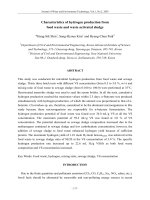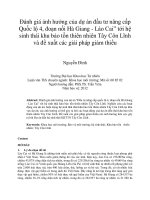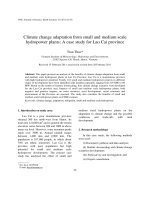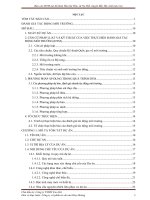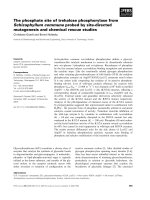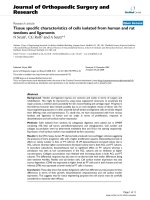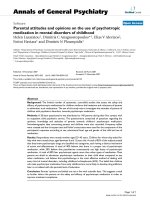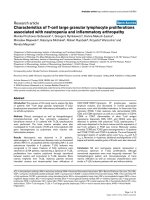Mineralogical characteristics of graphite ore from bao ha deposit, lao cai province and proposing a wise use VJES
Bạn đang xem bản rút gọn của tài liệu. Xem và tải ngay bản đầy đủ của tài liệu tại đây (965.74 KB, 13 trang )
Vietnam Journal of Earth Sciences, 39(4), 324-336, DOI: 10.15625/0866-7187/39/4/10728
Vietnam Academy of Science and Technology
(VAST)
Vietnam Journal of Earth Sciences
/>
Mineralogical characteristics of graphite ore from Bao Ha
deposit, Lao Cai Province and proposing a wise use
Hoang Thi Minh Thao*1, Tran Thi Hien 2 , Dao Duy Anh 2 , Pham Thi Nga 1
1
VNU University of Science, Vietnam National University, Hanoi, 334 Nguyen Trai Road, Thanh Xuan
District, Hanoi, Vietnam
2
National Institute of Mining, Metallurgy Science and Technology, 79, An Trach street, Dong Da
District, Hanoi, Vietnam
Received 30 June 2017. Accepted 07 August 2017
ABSTRACT
Graphite, especially, high quality graphite can be used in many industrial applications including metallurgy, batteries, fuel cells, and refractories. In 2011, Vietnam Ministry of Natural Resources and Environment issued a mineral
exploration license to explore Bao Ha graphite deposit, Bao Yen district, Lao Cai Province. The studied samples were
taken from 3 drill holes of the Bao Ha largest ore body. Different methods including light microscopy, X-ray diffraction (XRD), scanning electron microscopy (SEM), and carbon and sulfur analyzer were performed to identify its lithological and mineralogical characteristics as well as graphite quality, then propose a wise use of the resource. The
Bao Ha graphite is characterized as disseminated flake graphite in massive form, which developed in the sillimanite
schist and quartz-biotite schist of the Ngoi Chi formation. Graphite flakes occur as distorted clusters of flaky
plates/flakes within 50÷500 m, which is the medium size in comparison with the general grain size of graphite flake.
Graphite particle makes up 33÷43% by volume and graphitic content (Cg) makes up 10.0÷11.7 wt.%. Impurities include mainly quartz, biotite, and feldspar (combining of K-feldspar and anorthite, the primary ore) or kaolinite (the
weathered ore). This graphite ore should be refined to reach an ore concentration of at least 90% Cg for domestic industries of metallurgy, batteries, thermal materials, and refractories as well as for exports.
Keywords: Bao Ha graphite deposit, flake graphite, graphitic content, mineral composition.
©2017 Vietnam Academy of Science and Technology
1. Introduction1
Graphite (black lead or plumbago) is used
in many industrial applications due to its high
electrical and thermal conductivity, lubricity,
and chemical inertness. High-quality graphite
can be used in metallurgy, molding, brake linings, batteries, and fuel cells. Graphite, composed exclusively of Carbon element, is a
*
Corresponding author, Email:
324
common mineral, but their idiomorphic crystals are rare. Graphite is soft (hardness 0.5-1
of the Mohs scale), layered, planar structure.
The mineral occurs in platy or acicular (occasionally) morphology (Pierson, 1993).
Natural graphite deposits of economic interest are grouped into three main categories:
(i) microcrystalline graphite (commercially,
referred to amorphous graphite); (ii) vein
graphite (lump and chip); and (iii) crystalline
Hoang Minh Thao, et al./Vietnam Journal of Earth Sciences 39 (2017)
flake graphite (plumbago) (Asbury Carbons,
2015; Pierson, 1993; U.S Geological Survey,
2007). Microcrystalline graphite is the most
abundant form but occurs at the lowest in
grades. This type of graphite is used for lower
value graphite products, such as pencils, brake
pads, and rubber additives. Large microcrystalline graphite deposits are found in China,
Mexico, and United States (Plumbago Co.,
2013; Pierson, 1993; U.S Geological Survey,
2007). Vein graphite is the epigenetic origin,
formed by direct deposition of solid, graphitic
carbon from subterranean, high-temperature
fluids. This type is the most valuable and of
the highest quality, but also the rarest source.
Up to date, Sri Lanka is the only country that
produces vein graphite.
Flake graphite is less common but more
favorable than microcrystalline graphite because of its higher quality. Flake graphite is
used in many applications including, but not
limited to, powder metallurgy, fuel cell bipolar plates, coatings, thermal materials, friction
moderators, electrically conductive materials,
refractories (bricks which line furnaces in the
steel industry), general lubricant applications,
pencils, gaskets, rubber compounds, and other
advanced polymer systems. China, Brazil, and
Canada are the largest producers of flake
graphite (Asbury Carbons, 2015; Pierson,
1993; Plumbago Co., 2013; U.S Geological
Survey, 2007). Flake graphite deposit fall in
the category of syngenetic origin, formed
through the metamorphic evolution of carbonaceous matter dispersed in the sediments
(Mitchell, 1993; Rodas et al., 2000). Simandl
and his team (Simandl et al. 1995, 2015) also
concluded that disseminated graphite flakes
are in a variety of rocks including marble,
paragneiss (a meta sedimentary gneiss), iron
formation, quartzite, pegmatite, syenite, and,
in extremely rare cases, serpentinized ultramafic rocks.
The importance of graphite has been emphasized by the EU. In 2010, the European
Commission created a list of 41 different Critical Raw Materials (CRMs) for the European
economy, in which graphite was named in the
first 14 materials ranked at a high level in
both economic importance and supply risk
(European Commission, 2010). According to
Persistence Market Research (2015), the global graphite market was valued at US$13.6 billion in 2013 and is estimated to reach
US$17.5 billion by 2020, growing at a compound annual growth rate of 3.70% from 2014
to 2020. Worldwide consumption of graphite
steadily increased since 2012 and into 2016.
This increase resulted from the improvement
of global economic conditions and its impact
on industries that use graphite (U.S. Geological Survey, 2017). Graphite industry is dominated by large manufacturers located mainly
in China, India, Brazil, and some other countries. China, the world's leading producer of
natural graphite, now focuses on serving their
own domestic needs as well as pushes to
manufacturer higher value goods. Since 2010,
the price of high-quality flake grades of natural graphite has increased by 140% as a result
of Chinese policy and struggling production
elsewhere (Industrial Minerals, 2012). Graphite produced in India and Brazil is also mainly
consumed within the domestic markets, with
demand pouring in from refractories, foundries, lubricants, pencils, and other relevant applications. Facing to this situation, countries
including Vietnam, which own some graphite
resource, need to have policies for finding raw
materials, developing processing technologies, and using it sustainably.
The small reserves and inferred resources
of graphite in Vietnam, calculated for the 10
assessed and explored deposits and mines,
concentrated mainly in the northwest region,
325
Vietnam Journal of Earth Sciences, 39(4), 324-336
are 16.56 and 5.833 million tons, respectively
(Tran Van Tri and Vu Khuc, 2001). The Vietnamese graphite resources were formed with 2
origins: (1) sedimentary-metamorphic origin distributed in the Red River metamorphic
zone and Quang Nam, Quang Ngai Provinces;
the typical one is Nam Thi mine (Lao Cai
Province) including 3 areas, namely Nam Thi,
Nam Cay and Lang Oi; (2) metasomatic
origin - distributed in Tuyen Quang, Thai
Nguyen, Thanh Hoa and Quang Nam Provinces. Vietnamese graphite products have
reached just medium grade, from 80÷85%
graphitic carbon (Cg) and the small amount of
~92% Cg (Tran Thi Hien et al., 2008). In order to find high-grade graphite for domestic
industries of metallurgy, batteries, thermal
materials, and refractories, we have imported
graphite.
Bao Ha graphite deposit is situated within
the Red River metamorphic zone, which consists of also the well-known Nam Thi graphite
mine. The Ministry of Natural Resources and
Environment (Vietnam) issued a mineral exploration license No. 1095/GP-BTNMT dated
on 07/6/2011 for Song Da Lao Cai Mining
Joint Stock Company to explore the Bao Ha
graphite deposit. The Bao Ha graphite must be
used wisely and sustainably. Therefore, an
understanding of lithological and mineral
characteristics is necessary and useful for developing a suitable and specific mineral processing flowsheet for the Bao Ha graphite.
Further, detail investigation on graphite crystals can help to evaluate the quality of the Bao
Ha graphite product and propose a wise use
this resource.
2. Geology of Bao Ha graphite deposit
The Bao Ha graphite deposit is located in
Bao Ha commune, Bao Yen district, Lao Cai
Province. The deposit belongs to the middle
326
part of the Red River tectonic structure, which
characterized by paleo-metamorphic formations lying between the Red River and the
Chay River faults and extending from the
Vietnam-Chinese border to the Bac Bo Plain.
The deposit includes 11 graphite ore bodies,
whereas 6 bodies present higher grade than
the others (Bien Xuan Thanh, 2014; Luu Huu
Hung, 2001) (Figure 1). The ore bodies extended in the northwest-southeast and plunged
into monocline dipping to the northeast with
dip angle varying from 30-60o. Some bodies
have been deformed and pulverized, so that
their structure is discontinued and complicated. Almost of the ore bodies has been exposed
to the surface and partly weathered.
All of the 11 ore bodies are located in the
lower part of Ngoi Chi formation (PR1 nc1)
(Pham Van Long et al., 2004; Garnier et al.,
2008; Tran Xuyen, 1988) (Figure 1). The
formation was observed comprising of sillimanite schist (± biotite, garnet), quartz-biotite
schist (± sillimanite, garnet), garnet schist (±
biotite), biotite gneiss lens, and small amphibolite vein. The two first ones hold graphite
mineralization. Geological characteristics of
the deposit also include pyroxenite and hornblendite of the second phase of the Bao Ai
complex (2 PR1 ba ?) (Hoang Thai Son et al.,
2000) as well as pegmatite veins of the second
phase of the Tan Huong complex (2 P th)
(Hoang Thai Son, 1997). Besides, the Bao Ha
area was formed by also high-grade metamorphism rocks of Nui Con Voi formation (PR1
cv) (Nguyen Vinh & Phan Truong Thi, 1973)
and undivided Quaternary sediment. The Nui
Con Voi Complex part 2 occurs with paragneiss rich in plagioclase, biotite, sillimanite,
and almandine containing many amphibolite
lenses. The formation was observed with
some ore bodies which contain low-grade
graphite.
Hoang Minh Thao, et al./Vietnam Journal of Earth Sciences 39 (2017)
Figure 1. Geological map of Bao Ha graphite Deposit (adopted from Bien Xuan Thanh, 2014)
3. Material and Methods
3.1. Material
Twenty tons of ores were collected from 3
drill holes 110, 111, and 112 of the ore body
TQ.2, the largest ore body of the Bao Ha
graphite deposit. The ores were divided into
primary ores and weathered ores. The representative samples were named: G-LK 110, GLK 111, G-LK 112 for primary ores of the drill
holes 110, 111, 112, respectively; and G-PH
110, G-PH 111, G-PH 112 for weathered ores
of the drill holes 110, 111, 112, respectively.
The grinded mixtures of primary ore (BHGC01), weathered ore (BH-PHC02), and the
whole ore (BH-C0) were also studied. Graphite
ore concentrations (BH-QTC1 for -35+100
mesh and BH-QTC2 for -100 mesh), which
were treated with one froth flotation cycle at
National Institute of Mining - Metallurgy Science and Technology, Vietnam (VIMLUKI),
were subjected to investigate in details the single particles of graphite.
3.2. Methods
3.2.1. Light microscopy
The hand samples of graphite-bearing
rocks were made into thin sections, measuring
roughly 30 microns in thickness. The slides
were studied under a Leica DM750P light microscope with an integrated camera and a 10×
objective lens (at VNU University of Science)
327
Vietnam Journal of Earth Sciences, 39(4), 324-336
to obtain mineralogical and petrographic details of ore-bearing formation.
3.2.2. X-ray diffraction (XRD)
The mineralogical composition of randomly
oriented powdered samples with <40 μm size
fraction of the Bao Ha ore was investigated using a Siemens D5005 X-ray diffractometer (Cu
tube, Kα1,2 radiation, 40 kV, 30 mA) at VNU
University of Science. The XRD data were
processed using BGMN Rietveld software
(Bergmann et al., 1998; Kleeberg et al., 2005;
Ufer et al., 2008).
3.2.3. Scanning electron microscopy (SEM)
Mineral analyses were carried out at the
Department of Mineralogy and Petrology, Institute of Earth Sciences, University of Graz
using a JEOL JSM-6310 scanning electron
microscope (SEM) equipped with a Link ISIS
(Oxford) energy dispersive X-ray (EDX)
spectrometer. Analytical conditions were an
acceleration voltage of 15 kV and a probe current of 6 nA. Detection limit is 0.10 wt.%.
The grinded or powder ore samples were
mixed with Canada balsam to prepare thin
plate for the technique.
3.2.4. Carbon and sulfur analyzer
Carbon and sulfur contents of the Bao Ha
raw ores were analyzed by a Horiba EMIA320V2 carbon & sulfur analyzer at National
Institute of Mining - Metallurgy Science and
Technology, Vietnam.
4. Lithological and mineral characteristics
of Bao Ha graphite deposit
In regard to the host rocks and deposit
types, the classification scheme most widely
accepted for graphite deposits was introduced
by Cameron (1960). It classifies known
graphite deposits into five categories reflecting the different types of graphite: (i) Disseminated flake graphite in silica-rich metasediments; (ii) Disseminated flake graphite in
328
marbles; (iii) Metamorphosed coal seams;
(iv) Contact metasomatic or hydrothermal deposits in metamorphosed calcareous sediments or marble; and (v) Vein deposits. Based
on the geological characteristics of the Bao
Ha deposit and surrounding area, it is expected that the study deposit falls into the first
type. The Bao Ha graphite was observed as
flakes disseminated in schist of the lower part
of the Ngoi Chi formation (PR1 nc1) as mentioned above. Thin section study (Figure 2-5)
also verifies this identification. Under light
microscopy, graphite flake can be recognized
based on its opaque property. The typical
mineral assemblage of the foliated host rock
observed is feldspar, quartz, and biotite. Feldspar particles often showed <0.2 mm (Figures.
2, 5), seldom showed ~0.5 mm (Figure 3).
Some feldspar particles showing clear polysynthetic twinning were identified as plagioclase. Striation and fracture surfaces were
usually observed for feldspar. This mineral
has been altered into kaolinite, epidote, and
zoisite. Quartz presents an amount as high as
the amount of feldspar but with smaller particle size. Biotite is also very popular in the
samples, presents <0.6 mm (Figure 2-5),
sometimes very fine particle. This sheet silicate occurred interlayered with graphite (Figure 5) which may be difficult to remove during froth flotation.
This type of graphite deposit and host rock
was described for the well-known Bissett
Creek deposit in western Ontario, Canada
(Northern Graphite Corporation, 2015). The
Bissett Creek graphite flakes are disseminated
in silica-rich meta-sediments associated with
older rocks, notably those of Precambrian age,
which have undergone a high degree of regional metamorphism, forming gneisses,
schists, and quartzites. The host rocks of Bissett Creek graphite vary from quartz-mica
schists, to quartz-feldspar-biotite gneisses
with and without garnet, to semi-pelitic
schists.
Hoang Minh Thao, et al./Vietnam Journal of Earth Sciences 39 (2017)
Figure 2. Fine particles of biotite (yellow) and quartz
integrated with coarser particle of feldspar; black
particles are graphite (sample G-LK 110, Nicol +)
Figure 3. Assemblage of quartz (dark grey), biotite (yellow), feldspar (light grey) altered to kaolinite and epidote;
black particles are graphite (sample G-LK 111, Nicol +)
Figure 4. Block of fine grain of quartz, biotite,
feldspar contains graphite flake (sample G-LK 111,
Nicol -)
Figure 5. Dissemination of graphite flake(black) in the rock
comprising of quartz, biotite, and feldspar (sample G-LK
112, Nicol +)
Semi-quantity evaluation of the mineral
composition of the Bao Ha graphite ore
was carried out by XRD study using randomly oriented powder samples, which
were represented by the whole collected
samples of drill holes 110, 111, and 112 of
the ore body TQ.2. The results (Table 1,
Figure 6) show that graphite ranges up to
43% by volume. Quartz and biotite make
up from 26÷29% and 4÷10% by volume.
Total proportions of feldspar comprising
both plagioclase and K-feldspar of primary ores are as high as the proportions of
quartz. However, almost feldspar was altered into kaolinite in the weathered ores.
A trace amount of kaolinite and other
minerals in the primary samples could not
be detected by XRD measurement.
Besides main minerals, some minor and
trace minerals including garnet (Grt), pyroxene (Px), sphene or titanite (Ttn), limonite
(Lm), pyrite and/or pyrrhotite (Py), chalcopyrite (Cpy), and ilmenite (Ilm) were identified
by SEM-EDX study (Figures 7, 8). By this
technique, feldspar species were chemically
examined as K-feldspar and anorthite (Cafeldspar).
329
Vietnam Journal of Earth Sciences, 39(4), 324-336
Table 1. Mineral composition of Bao Ha graphite ore, as determined by XRD study, %
Mineral
G-LK 110 G-LK 111 G-LK 112 G-PH 110
Graphite
35
33
37
38
Quartz
27
29
29
29
Biotite
10
8
7
6
Feldspar
28
29
27
0
(Plgioclase+K-Feldspar)
(14+14)
(19+10)
(13+14)
(0+0)
Kaolinite
0
0
0
22
Others
0
1
0
5
Total
100
100
100
100
G-PH 111
42
28
7
0
(0+0)
23
0
100
G-PH 112
43
26
4
3
(0+3)
24
0
100
Figure 6. XRD patterns of Bao Ha graphite ore samples, °2Θ CuKα position
In the Bissett Creek graphite deposit, the
minor rock-forming minerals and ubiquitous
trace minerals reported are quite similar to the
Bao Ha graphite deposit: amphibole, clinopyroxene, chlorite, carbonate, garnet, sphene,
apatite, zircon, pyrite and pyrrhotite (Northern
Graphite Corporation, 2015). Pestpaksha
graphite deposit in Russia holds the similar
mineral composition: quartz, feldspar, biotite,
garnet, pyroxene, amphibole, chlorite, kaolinite, kyanite, pyrrhotite, rutile, and anatase
(Volkova et al., 2011). All of the associated
minerals need to be removed during ore refining processes. Therefore, mineral processing
330
technology for the Bao Ha graphite can learn
from the two mentioned deposits.
In conclusion, Bao Ha graphite deposit is
characterized by disseminated flake graphite
in mostly quartz-biotite schist of the Ngoi Chi
formation. Main minerals of the host rocks include quartz, biotite, and feldspar (K-feldspar
and anorthite), which was altered into kaolinite (and traces of epidote and zoisite) in the
weathered samples. Minor and trace minerals
can be listed with garnet, pyroxene, sphene or
titanite, limonite, pyrite and/or pyrrhotite,
chalcopyrite, and ilmenite.
Hoang Minh Thao, et al./Vietnam Journal of Earth Sciences 39 (2017)
Figure 7. SEM image showing flake graphite (Gra),
quartz (Qz), K-feldspar (K-Fsp), anorthite (Ca-Fsp),
kaolinite (Kao), sphene (titanite: Ttn), limonite (Lm),
ilmenite (Ilm) and pyrite or pyrrhotite (Py)
5. Quality of Bao Ha graphite and proposing a wise use
Type of graphite particle, impurities, and
graphitic content are key criteria to evaluate
quality of the Bao Ha graphite.
Observing the Bao Ha graphite ore samples with the naked eye and light microscopy
identified graphite crystals consisting of distorted clusters of flaky plates/flakes on a matrix. Other type of graphite like large thick
hexagonal crystals or rounded ball-like aggregates or radiating spheres could not be found.
The Bao Ha graphite which occurs as crystalline flake disseminated within 50÷500 m
(Figure 2-5). Asbury Carbons (2015) reviewed general size for flake graphite as
50÷800 m whereas Bissett Creek (Northern
Graphite Corporation, 2015) was reported that
its graphite generally forms flakes averaging
300÷1500 m long and 30÷70 m wide.
Therefore, the Bao Ha graphite flake falls into
the medium level.
Based on lithological and mineralogical results, impurities of the Bao Ha graphite are
common minerals of the host rock, particularly quartz, biotite, feldspar, and kaolinite. Mica, a sheet silicate, can be interlayered with
graphite. Kaolinite, also a sheet silicate and
very fine particle, may coat the graphite. The-
Figure 8. SEM image showing flake graphite (Gra),
quartz (Qz), K-feldspar (K-Fsp), anorthite (Ca-Fsp),
pyroxene (Px), garnet (Grt), chalcopyrite (Cpy), pyrite or
pyrrhotite (Py), and ilmenite (Ilm)
se minerals will complicate graphite processing. With the exception of mica and kaolinite, theoretically, most of the impurities are
easily separated because graphite is the easiest
to float using froth flotation (Michell, 1993;
Northern Graphite Corporation, 2015; Lu and
Forsberg, 2001, 2002). However, the growth
of these minerals will decide purity of products of graphite processing.
A SEM-EDX mapping analysis (Figure 9)
of ungrounded primary ore shows obviously
that graphite flake associated intimately with
other minerals represented by Si, Al, Fe, Ca,
K, and Ti elements, even at small scale
(~10 m). The presences of both K-feldspar
and anorthite (Ca-feldspar) were proved with
these mapping images, too.
To evaluate the quality of the Bao Ha
graphite ore, graphitic content (Cg) was analyzed (Table 2). The weathered ore samples
present higher Cg than that of the primary
samples. Cg varies within a narrow range of
10.2÷11.7. The values are suitable with the
proportions of graphite by volume yielded
from XRD analyses combining with Rietveld
refinement (Table 1). The Cg of the Bao Ha
ore is a little bit lower than that of the 2 greater (among total 8) ore bodies of the Nam Thi
graphite mine with 12.45 % (Tran Van Tri &
Vu Khuc, 2001). However, the yielded Cg
331
Vietnam Journal of Earth Sciences, 39(4), 324-336
values are much higher than those of the Bissett Creek deposit with only 1.65-1.74% (at a
1.02% cut off grade) (Northern Graphite Corporation, 2015).
Figure 9. SEM-EDX mapping shows graphite flakes associated intimately with other minerals represented by Si, Al,
Fe, K, Ca, and Ti elements
In order to investigate upgrade possibility of
Cg and separation performance between graphite and impurities, the Bao Ha ore concentrations treated with one froth flotation cycle were
carried out by SEM-EDX. Both coarser particles (-35+100 mesh) and finer particles (-100
mesh) show that graphite seems to be intimately associated with other minerals (Figure 10).
One froth flotation cycle could not remove
mostly neither free impurity nor integrated impurity. Some more froth flotation cycles and
even chemical purification are essential to produce high purity graphite. Lu and Forssberg
(2001, 2002) mentioned that, in general, by the
process of scrubbing and two-step flotation, a
fine graphite concentrate containing 8788% Cg can be upgraded to about 95% Cg, but
further upgrading by flotation is difficult. With
such observed intimate association of the Bao
Ha graphite and impurities, it seems to be impossible to catch a product with more than 95%
Cg without chemical refining.
Table 2. Graphitic content of Bao Ha graphite ore, wt.%
Content
G-LK 110
G-LK 111
G-LK 112
Cg
10.2
10.0
10.2
G-PH 110
10.6
G-PH 111
11.5
G-PH 112
11.7
Figure 10. Graphite ore concentration treated with one flotation cycle shows small particles of other minerals
associated with graphite. A) -35+100 mesh sample (BH-QTC1), B) -100 mesh sample (BH-QTC2)
332
Hoang Minh Thao, et al./Vietnam Journal of Earth Sciences 39 (2017)
The sulfur content in the whole collected
raw ore (sample BH-C0) reaches 2.0%, which
is unacceptable in many applications such as
lubricants and dry cell batteries. Lu and
Forssberg (2002) suggested an alkali roasting
process, which consists of roasting with caustic soda, water washing, and sulfuric acid
leaching, as an effective method for graphite
purification which can reduce sulfur content
to be low 0.05% in the end product.
Combining all of the criteria, the Bao Ha
ore (TQ.2) can be roughly graded as mediumquality flake graphite: medium flake size
(positive), the intimate growing of minerals
(negative), high Cg (positive), and high sulfur
content (negative).
Because flake graphite is more valuable
and more favorable than microcrystalline
(amorphous) graphite, the Bao Ha graphite
ore should be refined to get high-grade graphite for domestic industries or value-added
product exports. As mentioned in the introduction chapter, Vietnam has to import highgrade graphite for metallurgy, batteries, thermal materials, and refractories, but Chinese
graphite production and exports are likely to
decline in the future. Therefore, stable and secure sources of high-quality graphite supply in
Vietnam are needed.
For the domestic industries, following
TCVN 4688:1989 (Vietnam Standards and
Quality Institute, 1989), the best graphite
type, marked as Gr-S, with Cg of 95% or
more can be used for electrodes and high-end
pencil; the second best graphite type, marked
as Gr - P, with Cg of 82% or more can be
used for batteries. However, high-quality batteries, electrodes, and bricks (for refractories)
need refined graphite with much higher Cg
(about 95÷99%).
In regard to the exports, Circular No.
12/2016/TT-BCT dated 5 July 2016 of the
Ministry of Industry and Trade (amending a
number of articles of the Circular No.
41/2012/TT-BCT dated 21 December 2012)
on the export of minerals included that refined
graphite with Cg of 90% or more is allowed to
export until the end of 2020 (Ministry of
Industry and Trade, 2006). All types of commercial flake graphite traded in the global
market have to have more than 85% Cg (U.S.
Geological Survey, 2012; Industrial Minerals,
2011, 2012). Therefore, the Bao Ha refined
graphite has to reach at least 90% Cg if an investor wishes to export.
In conclusion, with medium flake size and
high Cg, the Bao Ha graphite ore should be refined with a suitable mineral processing flowsheet to reach an ore concentration of at least
90% Cg for domestic industries and exports.
Because of the intimate growing of minerals
and high sulfur content, processing, and refining technology study as well as cost-benefit
study should be performed to understand the
possibility of upgrading refined graphite of Bao
Ha ore to 95% Cg or more.
6. Conclusions
Graphite of the Bao Ha deposit developed
in the silica-rich schist of the Ngoi Chi formation (PR1 nc1). Two elements observed
comprising sillimanite schist (± biotite, garnet) and quartz-biotite schist (± sillimanite,
garnet) present graphite mineralization.
Studying the samples taken from the drill
holes 110, 111, and 112 of the TQ.2, the largest ore body, shows that the graphite of the
TQ.2 seems to be associated with quartzbiotite schist (Figures 2-5). Impurities in the
Bao Ha graphite are minerals of the host rock,
particularly quartz (26÷29% by volume), biotite (4÷10% by volume), and feldspar
(27÷29% by volume for the primary ore) (Table 1). The feldspar species were substituted
by mostly kaolinite in the weathered samples.
Minor and trace minerals identified by SEMEDX measurements include garnet, pyroxene,
sphene (titanite), limonite, pyrite and/or pyrrhotite, chalcopyrite, and ilmenite (Figures 7,
8). SEM-EDX analyses and mapping also
333
Vietnam Journal of Earth Sciences, 39(4), 324-336
prove that feldspar includes K-feldspar and
anorthite (Figures 7-9).
Bao Ha graphite ore occurs in massive
form. The graphite is characterized as disseminated flake graphite, which occurs as distorted clusters of flaky plates/flakes within
50÷500 m (Figures 2-5). Graphite flakes associated intimately with the impurities even at
very small scale (~10 m) (Figures 9-11).
Based on XRD measurement combining with
BGMN Rietveld refinement, graphite crystal
makes up 33÷43% by volume, in which the
proportions in the weathered samples are
higher than those in the primary samples
(Table 1). Carbon analysis shows Cg for the
Bao Ha graphite ore varying from
10.0÷11.7 wt.%. In comparison with general
grain size and graphitic concentration of the
flake graphite deposit, it can be roughly concluded that Bao Ha graphite present medium
grade. This graphite ore should be refined to
reach an ore concentration of at least 90% Cg
for domestic industries of metallurgy, batteries, thermal materials, and refractories as well
as for exports (if necessary). Upgrading refined graphite of Bao Ha ore to 95% Cg or
more is very difficult because of the intimate
growing of minerals and high sulfur content.
The Bao Ha ore concentrations treated with
one froth flotation cycle still show many small
particles of impurities in both coarser particles
(-35+100 mesh) and finer particles (-100
mesh) (Figure 10), so that some more froth
flotation cycles and even chemical purification are essential to produce high purity
graphite.
Nguyen Thi Minh Thuyet and Dr. Nguyen
Van Huong (VNU University of Science) for
some analyses and supports. We also thank
two anonymous reviewers and the Editor for
their evaluation.
Acknowledgements
Hoang Thai Son, Pham Ngoc Thach, Nguyen The
This research was supported by the Ministry of Science and Technology, Vietnam under grant number 44/15-ĐTĐL.CN-CNN. We
are very grateful to Prof. Christoph A.
Hauzenberger, Dr. Le Thi Thu Huong (Graz
Geocenter - Petrology & Geochemistry, KarlFranzens-University Graz, Austria), Dr.
334
References
Asbury Carbons, 2015. Natural graphite - Introduction
to natural graphite. on April 26, 2015).
Bergmann J., Friedel P., Kleeberg R., 1998. BGMN - a
new fundamental parameters based Rietveld program for laboratory X-ray sources, its use in quantitative analysis and structure investigations. CPD
Newsletter 20, 5-8.
Bien Xuan Thanh (Editor), 2014. Exploration of graphite deposit in Bao Ha area, Bao Ha community, Bao
Yen district, Lao Cai province. Report. Song Da Lao
Cai Mining Joint Stock Company.
Cameron E., 1960. Graphite: Industrial Minerals and
Rocks. Seeley W. Mudd Series, AIME (Chapter 20).
European Commission, 2010. Report lists 14 critical
mineral raw materials. />
(Ac-
cessed on April 26, 2015).
Garnier V., Giuliani G., Ohnenstetter D., Fallick A.E.,
Dubessy J., Banks D., Vinh H.Q., Lhomme T., Maluski H., Pêcher A., Bakhsh K.A., Long P.V., Trinh,
P.T., Schwarz D., 2008. Marble-hosted ruby deposits from Central and Southeast Asia: Towards a new
genetic model. Ore Geology Reviews, 34, 169-191.
Hoang Thai Son (Editor), 1997. Geological and Mineral
Resources Map of Vietnam at 1:50,000 scale, sheets
Doan Hung - Yen Binh. General Department of
Geology and Minerals of Vietnam.
Trung, Chu Hong Phong, Nguyen Ngoc Dung, Pham
Xuan Doanh, 2000. Disscussion about metamorphism facies of Song Hong Series. Proceedings.
General Department of Geology and Minerals of
Vietnam.
Industrial Minerals, 2011. Supply Situation Report:
Graphite demand soars above precrisis levels.
Hoang Minh Thao, et al./Vietnam Journal of Earth Sciences 39 (2017)
/>90 (Accessed on April 04, 2011).
Industrial Minerals, 2012. The Natural Graphite Report
2012-Data, analysis and forecast for the next five
years.
/>2012.pdf.
Kleeberg R., Ufer K., Bergmann, 2005. The Quantification of Disordered Clay Minerals by the Rietveld
Method - Some Practical Aspects. Presentation at
the 42nd Annual Meeting of the Clay Minerals Society, June 11-15, 2005, Burlington/Vermont.
Lu X. and Forssberg E., 2001. Flotation selectivity and
upgrading of Woxna fine graphite concentrate. Mineral Engineering, 14(l l), 1541-1543.
Lu X. and Forssberg E., 2002. Preparation of high-purity
and low-sulphur graphite from Woxna fine graphite
concentrate by alkali roasting. Minerals Engineering.
15(10), 755-757.
Luu Huu Hung (Editor), 2001. Evaluation on graphite of
Bao Ha area, Bao Yen, Lao Cai. Report. General
Department of Geology and Minerals of Vietnam.
Ministry of Industry and Trade, 2016. Circular - amending and supplementing a number of articles of the
Minister of Industry and Trade’s circular no.
41/2012/TT-BCT of December 21, 2012, providing
the export of minerals (July 05, 2016).
/>Mitchell C.J., 1993. Industrial Minerals Laboratory
Manual - Flake Graphite. Technical Report. British
Geological Survey.
Nguyen Vinh, Phan Truong Thi, 1973. Distribution of
contact and dynamic metamorphic rocks in Yen Bai
- Nghia Lo area. Journal of Sciences and Techniques
of Mining and Geology (ISSN: 1859-1469), 22, 113. Hanoi University of Mining and Geology.
Northern Graphite Corporation, 2015. Bissett Creek
Project. < Accessed on April 30, 2015.
Persistence Market Research, 2015. Global market
study on graphite: Battery segment to
witness highest growth by 2020.
/>Pham Van Long, Hoang Quang Vinh, Garnier V.,
Giuliani G., Ohnenstetter D., Lhomme T., Schwarz
D., Fallick A., Dubessy J., Phan Trong Trinh, 2004.
Gem corundum deposits in Vietnam. Journal of
Gemmology, 29(3), 129-147.
Pierson H.O., 1993. Handbook of carbon, graphite, diamond and fullerenes - Properties, Processing and
Applications. Noyes Publications.
Plumbago
Co.,
2013.
What
is
graphite.
(Accessed on April 26,
2015).
Rodas M., Luque F.J., Barrenechea J.F., FernándezCaliani J.C., Miras A., Fernández Rodríguez C.,
2000. Graphite occurrences in the LowPressure/High-Temperature metamorphic belt of the
Sierra de Aracena (Southern Iberian Massif). Mineralogical Magazine, 64, 801-814.
Simandl G.J., Paradis S., Valiquette G., Jacob H.L.,
1995. Crystalline graphite deposits, classification
and economic potential. Proceedings of 28th Forum
on the Geology of Industrial Minerals, Marinsburg,
West Virginia, May 3-8, 1992, 168-174.
Simandl G.J., Paradis S., Akam C., 2015. Graphite deposit types, their origin, and economic significance.
In: Simandl G.J. and Neetz M., (Eds.), Symposium
on Strategic and Critical Materials Proceedings, November 13-14, 2015, Victoria, British Columbia,
British Columbia Ministry of Energy and Mines,
British Columbia Geological Survey Paper 2015-3,
163-171.
Tran Thi Hien, Vu Tan Co, Chu Van Hoan, Vu Van Ha,
Bui Van Ngu, Nguyen Duc Minh, Nguyen Bao Linh,
Tran Duc Dung, 2008. Study about mineral processing technology for graphite ore from Nam Thi
mine - Lao Cai province. Report. National Institute
of Mining - Metallurgy Science and Technology,
Vietnam.
Tran Van Tri, Vu Khuc (Editors), 2001. Geology and
Earth Resources of Vietnam. General Department of
Geology and Minerals of Vietnam. Publishing
House for Science and Technology, 645p.
335
Vietnam Journal of Earth Sciences, 39(4), 324-336
Tran Xuyen (Editor), 1988. Geological and Mineral Resources Map of Vietnam at 1:200,000 scale, sheets
Bac Quang - Ma Quan. Map explanation. General
Department of Geology and Minerals of Vietnam.
U.S Geological Survey, 2007. 2007 Minerals Yearbook Graphite. U.S Geological Survey, 10.
U.S Geological Survey, 2012. Mineral commodity
summaries 2012. U.S Geological Survey, 68-69.
U.S Geological Survey, 2017. Mineral commodity
summaries 2017. U.S Geological Survey, 74-75.
Ufer K., Stanjek H., Roth G., Dohrmann R., Kleeberg
R., Kaufhold S., 2008. Quantitative phase analysis
336
of bentonites by the Rietveld method. Clay Mineral
56(2), 272-282.
/>Volkova S.A., Il’icheva O.M., Kuznetsov O.B., 2011.
X-ray study of the graphite-bearing rocks from the
Pestpaksha ore occurrence and structural features of
graphite. Lithology and Mineral Resources, 46(4),
363-368.
Vietnam Standards and Quality Institute, 1989. TCVN
4688:1989 Graphite concentrate - Marks and technical requirements.
